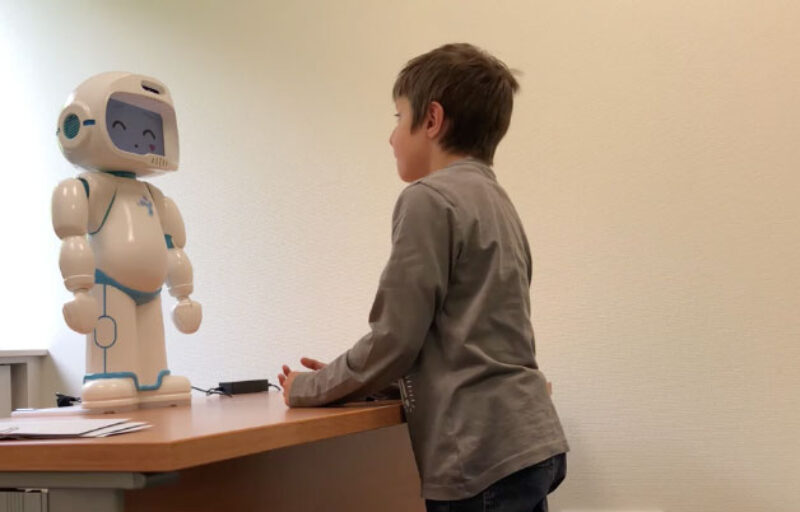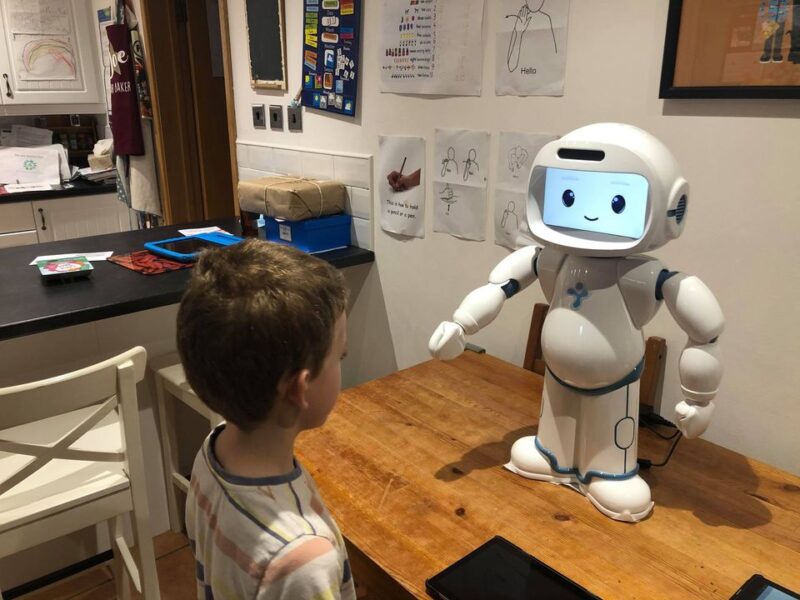Researchers have found that, like most children, also children with autism love playing with robots. Robots can deliver predictable responses over and over. They repeat things and behave in a consistent way, which are highly important to helping children with autism learn better. These are only a few reasons to why children with autism often perceive a robot as less intimidating than a human being, and why robots appear to be more advantageous in helping children with autism learn.
Children with autism often engage in a different way
Autism spectrum disorder (ASD) is specified by having social, communication and behavioural challenges. Children with autism often experience anxiety when they are dealing with social interaction with people around them including their peers, caregivers and teachers. Anxiety causes difficulties for children with autism in getting engaged in social interaction and staying focused while working collaboratively with another person. Given the fact that many skills including the early communication, cognitive, language development and autonomy skills are learnt by observing others and engaging with them, we often see a delayed development in one or several areas in children with autism.
On the other hand, children with autism tend to engage easily in activities when their nature is predictable, consistent, and free of social demands. We often find children easily get engaged with using technology. Sometimes, children can show very advanced skills in using tablets and computers from an early age. This engagement can open a door towards having a productive teaching time.
Robots helping children with autism learn
Since about 2 decades, a new form of technology called socially assistive robots, entered the field of autism therapy research. These robots are designed to help children with autism learn various social, emotional, communication and cognitive skills. The goal is to use a robot as an embodied form of technology that provides a great level of simplicity, exaggeration, consistency and predictability to improve the engagement of children with autism, but also to interact in a way that is social in nature.
As a technology with social existence, the robot stands somewhere between the world of technology and social humans. With a robot, children can practice new skills in a way that is more similar to interacting with a human, but not as complex and dynamic. In this case, when a child interacts with a robot, it is easier for them to learn skills that are transferable to their day-to-day life.
Based on research, the impact of social robots on children with autism can be categorised in 6 categories:
1. Improve engagement
Scientific studies and empirical use of robots at home and at school show that the first impact of robots on children with autism is improving their engagement and attention. There are more than 10 studies showing that when children with autism are working with robots, they have a better engagement and longer gaze duration compared to the times they are working with a human carer. The robots initially trigger curiosity and excitement that elicits engagement. In longer term use, what improves children’s engagement is the predictability and consistency in the robot’s behaviour and not having any social judgment or demands.

2. Reduced anxiety and disruptive behaviours
The unpredictable form of social interaction and not knowing what to expect often triggers anxiety in children with autism. The response to this anxiety in autistic children can be seen as increased stereotypical behaviours and stimming or as trying to get disconnected from the interaction that causes the anxiety. Research shows that when children are interacting with a social robot in an educational session, they have fewer stereotypical behaviours than the times they are doing the same activity with a human partner. Also, they can sustain the interaction for a longer period of time when they are learning from a robot.

3. Increased joint attention with the human partners in educational sessions
Joint attention with a learning partner is critical for learning. Joint attention with a human partner is necessary for practicing the skills that are meant to be used in day-to-day social interactions. Many studies demonstrate that using a robot in children’s education works as a mediator of joint attention between the child and the human caregiver.
The robots can create a collaborative and triangular learning interaction between the child, the human caregiver and themselves. This way the robot facilitates the learning in a way that is generalizable to the human-to-human interaction. Comparing a robot to other technology, for example, the nature of using a tablet is not collaborative. There is no role for a parent or therapist when the child is using a tablet. This is one of the main reasons that a robot as an assistive technology for autism is more effective than a tablet or a computer screen.

4. Improved collaboration and motivation
When autistic children are working with a robot, they are often highly motivated to respond. The reinforcements from the robot are also very effective on the children. Therefore, we can often see a higher motivation to learn and provide correct responses to get the reinforcements from the robot.
Additionally, many children tend to be more open to work on challenging topics with robots than with human caregivers. For example, practicing social skills or emotional skills are quite challenging. We see autistic kids tending to avoid practicing such activities with their teachers, but they show more interest when those type of skills are practiced using a robot.

5. Improved access to special needs education and frequent practice
Many children with autism and special needs education require frequent practice to learn new skills. Often, lessons should be repeated based on the needs of an individual learner, to see meaningful results and progress. However, in many cases, given the shortage of autism professionals, children would not have enough opportunity to practice in a structured and evidence-based way. That’s why we often see slower progress that is caused by long intervals between practice opportunities.
Technology has the power of mass replication of content. Once a robot for autism is programmed by an autism professional, it can deliver the sessions with the exact same quality repeatedly. Having a robot for autism as an at-home educational tool will allow children to have frequent and consistent practice that will directly impact their progress and development. Furthermore, a robot never gets tired, frustrated or discouraged. The robot always responds with the same positive and constant attitude. This makes frequent practice more appealing for children with autism who get distracted by change.

6. Improved educational outcome
The improved educational outcome when using a robot in special needs education and helping children with autism is due to the impact of all the above points. We can see that robots can facilitate learning and improve the outcome of teaching by;
- Increasing children’s engagement
- Reducing their anxiety
- Improving the motivation and collaboration
- Providing frequent chance of practice in a structured way
QTrobot for autism and special needs education
Who is QTrobot and how can he help children with autism? QTrobot is a little humanoid robot, designed as an assistive tool for special needs education. QTrobot has facial expressions that are simple, easy to understand and exaggerated. This will allow students with autism to be able to easily understand the robot’s emotions and get clear and motivating reinforcements when the robot is happy with their answers.
QTrobot helping children with autism learn emotions and positive social behaviors
QTrobot has a humanoid body allowing it to practice many important social and emotional skills. For example, how to have a proper personal distance, how to take turns and how to pay attention to non-verbal cues when having a conversation.
Together with QTrobot comes hundreds of educational units that are designed around play-based learning. QTrobot focuses on teaching skills that are age appropriate and structured. For example, QTrobot interacts with children, plays fun games, tells stories, and pretends to be many funny characters, always adapted to the level of the child.
The activities and units on QTrobot are designed based on the evidence-based practices. These include using prompting, error correction, social narratives and social skills training as well as visual support and modelling.
QTrobot teaching answering WHO questions to children with autism
Non-verbal children with autism can learn with QTrobot
The activities are very inclusive, allowing children who are non-verbal or minimally verbal to benefit from the educational games and learn the skills to have better receptive, expressive and communication abilities. Any child can use their own method of communication with QTrobot. QTrobot is user friendly for PECS users, AAC device users and children who use sign language.

Interested in learning more?
To learn more about the education curricula of QTrobot for autism and special needs education check here.
Interested to know if QTrobot can be a good support for your child or students?




